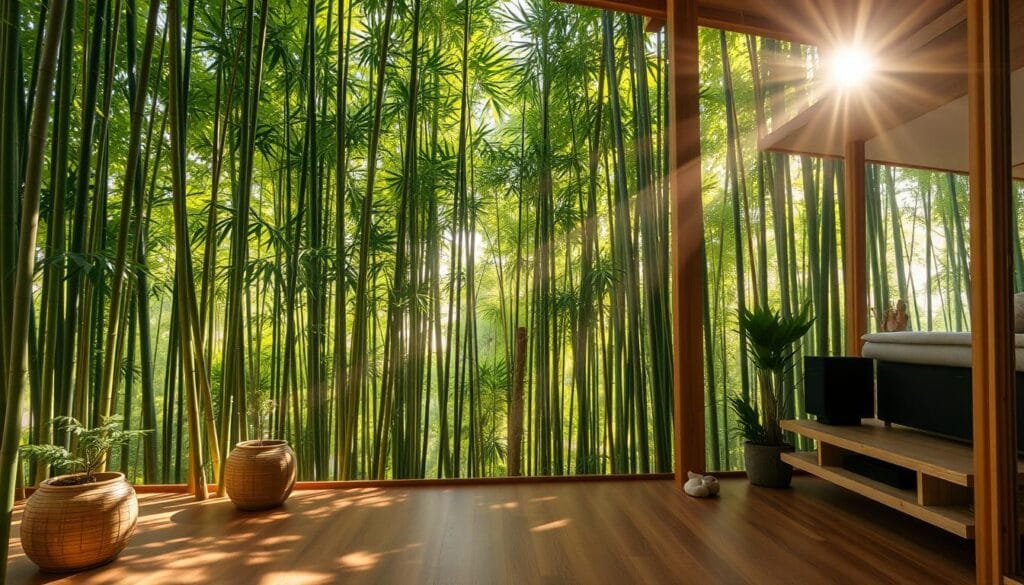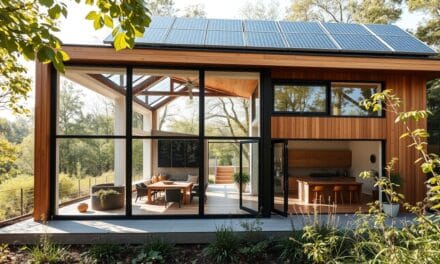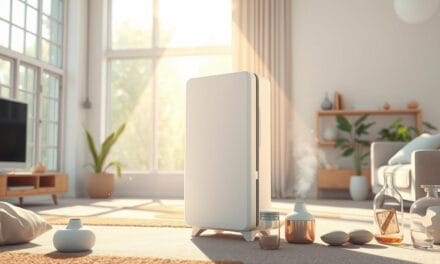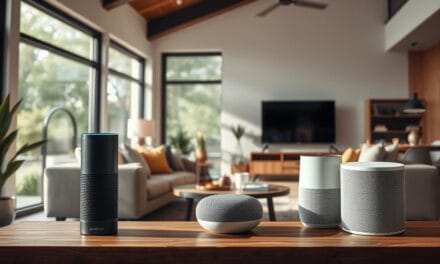Did you know that bamboo grows super fast? It can reach up to 80 feet in just one year. This fast growth shows bamboo’s great promise as a green hardwood flooring choice. Bamboo takes only five years to fully mature. It offers a strong and eco-friendly option that’s hard to ignore.
For those wanting green bamboo floors, there are lots of choices. Brands like Eco Timber, Teragren, and PlyBoo have many styles and finishes. These range from natural to darker shades to stained. Each choice makes bamboo floors look great without harming the planet. Bamboo floors can last longer than traditional woods like oak. Some types, like strand-woven bamboo, are extremely hard, even more than Brazilian redwood.
Key Takeaways
- Bamboo reaches its full height in just one year, making it a rapidly renewable resource.
- High-quality bamboo flooring options come from manufacturers such as Eco Timber, Teragren, and PlyBoo.
- Bamboo flooring can be more durable than traditional hardwood, with strand-woven options rivaling exotic woods like Brazilian redwood.
- Bamboo floors are eco-friendly, appealing to homeowners looking for sustainable hardwood flooring alternatives.
- The variety of bamboo flooring styles, including natural, carbonized, and stained, enhances the overall aesthetic appeal of any home.
Let’s look more at the best bamboo flooring choices out there. Bamboo stands out for eco-aware homeowners. It’s a great mix of being good for Earth, stylish, and tough. It’s a great choice for those wanting a lovely, green home.
Understanding the Benefits of Bamboo Flooring
Bamboo flooring is now a top choice for eco-friendly homeowners. It’s loved for its sustainability, strength, and looks. It’s perfect for today’s homes.
Durability and Longevity
Bamboo floors are very durable. They handle a lot of foot traffic and different weather well. Strand woven bamboo is even stronger, good for busy areas.
With proper care, bamboo floors can last up to 25 years. They might even reach 50 years if you maintain them well.
Eco-Friendliness
Bamboo floors are great for the environment. Bamboo grows back quickly, in 5 to 7 years, unlike hardwood trees which take up to 20 years. This means bamboo can be reused without harming our planet.
Also, bamboo floors are good for people with allergies. They don’t like dust mites and keep dust and pollen away. And, they’re pet friendly, too.
Aesthetic Appeal
Bamboo floors come in lots of designs. You can pick from natural looks to sleek, modern ones. There’s a style for everyone.
They offer different patterns like horizontal, vertical, and strand woven. Finishes range from Satin-Matt to Matt lacquer. Bamboo can match any home decor beautifully.
Types of Bamboo Flooring
Bamboo flooring has many options for different styles and needs. It is made in unique ways. There are classic, modern, and strong types of bamboo floors for homeowners.
Horizontal Bamboo
Horizontal bamboo flooring shows off bamboo’s natural beauty. It’s perfect for those who like a rustic look. You can get it in solid or engineered planks, which don’t warp easily.
Vertical Bamboo
Vertical bamboo flooring has a sleek and tidy look. It’s great for modern homes. The bamboo strips are placed upright, making it tough and resistant to dents.
Strand-Woven Bamboo
Strand-woven bamboo flooring is very strong and lasting. It’s made by pressing and gluing bamboo together. This type of flooring comes in many colors and is good for busy spots.
| Type | Features | Ideal For |
|---|---|---|
| Horizontal Bamboo | Prominent knots and grain patterns | Traditional/Rustic Style |
| Vertical Bamboo | Uniform, streamlined appearance with subtle grain | Contemporary Style |
| Strand-Woven Bamboo | Incredibly dense, twice as hard as oak | High-Traffic Areas |
In summary, bamboo flooring comes in styles like classic horizontal, simple vertical, or tough strand-woven. Each type offers beautiful and practical flooring choices for any home.
Bamboo Flooring Installation Methods
Choosing the right method for bamboo floor installation is key. There are four different methods to install plank-style bamboo flooring and one for parquet block bamboo. Every homeowner can find a suitable option.
The floating method is simple, great for DIYers. It uses a tongue and groove or uniclic system. It’s easy, works on many subfloors, and is easy to replace if needed.
The nail-down method provides great stability. It’s best for solid bamboo floors and attaches planks to wood subfloors. However, it requires more skill and special tools, so consider a professional.
Glue-down is another solid choice, perfect for concrete subfloors. It firmly attaches the flooring. Parquet block flooring also uses this method. It works on wood and concrete, but a pro is often best for this job.
- Floating Method: Works anywhere in the home, great for DIY fans.
- Nail Down Method: Best for solid floors, needs expertise.
- Glue Down Method: Good for all subfloors, pro help suggested.
Success with bamboo flooring starts with the subfloor. Wood subfloors must be flat, clean, and dry. Southern U.S. homes often have concrete subfloors that need checking for moisture. Flooring needs to sit in the room for 48 hours before installing.
Diving into DIY bamboo flooring? Know each method and what it needs. Seeking secure installation? Get help from a pro. They can ensure your floors look amazing and last long.
- Wood Subfloors: These include many types, like plywood and old boards.
- Concrete Subfloors: They need checking for moisture, suit many installation types.
- Above Grade Installation: Works well for certain home levels.
- Below Grade Installation: Choose moisture-resistant options for these areas.
| Installation Method | Pros | Cons |
|---|---|---|
| Floating | Simple to do, fits many subfloors | May not feel as firm |
| Nail Down | Very firm, perfect for solid bamboo | Needs skills and tools, not for damp places |
| Glue Down | Stays put, good for all subfloors | Best done by pros, a tough process |
Comparing Bamboo vs Hardwood Floors
Choosing floor materials leads us to the bamboo vs hardwood floors debate. Bamboo is great for budget-watching, eco-friendly folks. It grows fast, ready in 3 to 5 years. This is much quicker than the 20 to 30 years for an oak tree.
Cost comparison bamboo hardwood flooring is a key topic. Bamboo floors are about $3.80 per square foot. Prices go from $2 to $6 per square foot. Hardwood floors cost more, $4 to $8 per square foot, with special types even higher.
Bamboo floors are strong, similar to hard maple. They are tougher than red oak which has a lower score. Yet, some hardwoods like Brazilian teak are even harder. Bamboo is still a durable, sandable and refinable choice, like solid hardwood.
Bamboo floors last about 20 to 25 years with the right care. Hardwood floors can last up to 100 years. This makes hardwood floors more appealing for long-term goals. Bamboo is a good choice for those thinking about cost, green living, and toughness.
| Feature | Bamboo Floors | Hardwood Floors |
|---|---|---|
| Maturity Time | 3-5 years | 20-30 years |
| Cost per Square Foot | $2 to $6 | $4 to $10+ |
| Janka Hardness Rating | 1,300-1,400 | 1,220 (Red Oak), 1,450 (Hard Maple) |
| Maintenance Costs | Low | Moderate to High |
| Average Lifespan | 20-25 years | 100+ years |
Your choice between bamboo and hardwood floors relies on your own needs and values. Both offer benefits, whether you value being green, cost-saving, or durability.
Top Bamboo Flooring Brands
Looking for eco-friendly and durable floors is important. We will talk about three big brands: Eco Timber, Teragren, and PlyBoo. They are great because of their quality and care for the environment. We want to help you pick the best one by showing what makes them different.
Eco Timber
Eco Timber focuses on being green and high quality. They have many types of bamboo floors. You can pick from solid or engineered options. Eco Timber is good for those who want to help the planet and have long-lasting floors.
Shop Eco Timber Bamboo Flooring.
Teragren
Teragren is known for many colors and styles. They offer 12 lines with over 25 shades. This makes it easy to find the right look for your home. They have great prices, too, ranging from $5-8 per square foot. Teragren is all about giving you choices and value.
Shop Teragren Bamboo Flooring.
PlyBoo
PlyBoo is all about new ideas and being eco-friendly. With four lines and more than 25 colors, PlyBoo cares about variety. Their prices are good, between $4.30 and $6 per square foot. PlyBoo floors are very strong and don’t expand much. They are a smart pick for any home.
| Brand | Product Lines | Color Options | Price per Square Foot |
|---|---|---|---|
| Eco Timber | Multiple | Various | $4-$7 |
| Teragren | 12 | 25+ | $5-$8 |
| PlyBoo | 4 | 25+ | $4.30-$6 |
When you look at these bamboo flooring brands, you can find floors that are pretty and strong. They are good for the planet, too.
Cost of Bamboo Flooring
When picking bamboo flooring, it’s key to know about the costs. This helps us plan our budget for bamboo floors well.

Material Costs
Bamboo flooring prices change based on bamboo type and brand. Different bamboo floorings have various prices:
| Type | Cost per Square Foot |
|---|---|
| Engineered Bamboo | $2 – $5.50 |
| Horizontal Bamboo | $2 – $5.50 |
| Vertical Bamboo | $2.50 – $7.50 |
| Strand-woven Bamboo | $4 – $7.50 |
Top brands have these price ranges:
- Cali Bamboo: $3.50 – $8
- Lifeproof: $3 – $4
- Teragren: $6 – $10
- EcoFusion: $3 – $9
- Islander: $4.50 – $6.50
- USFloors: $3 – $4
- Morningstar: $2 – $4
- Home Legend: $2 – $5
Installation Costs
Installation costs change with room size and how tough the job is:
| Room Size | Cost Range |
|---|---|
| Small (120 sq. ft.) | $840 – $2,280 |
| Medium (224 sq. ft.) | $1,568 – $4,256 |
| Large (300 sq. ft.) | $2,100 – $5,700 |
Thinking about DIY installation for *affordable bamboo flooring*? It could lower labor costs. Normally, labor adds $2.50 to $6 per square foot.
Maintenance Costs
Maintenance costs for bamboo floors are like those for wood floors. Keeping the floor clean and cared for is important for its look and strength:
- *Bamboo flooring cost* includes buying special cleaners to prevent water damage.
- Polishing and refinishing over time also count in the cost.
- If kept well, bamboo flooring can last 25 to 35 years.
When planning your budget, consider these costs for short and long term. Picking the best bamboo flooring and planning for upkeep will make your investment worth it.
Best Bamboo Flooring Options for Eco-Conscious Homeowners
Choosing the top eco-friendly bamboo flooring needs a look at durability and the environment. Bamboo floors are super hard. Solid strand bamboo flooring is 2-3 times harder than oak. It can be refinished twice, lasting long without much care.
Solid strand bamboo flooring grows back in just five years. This makes it great for those who care about the planet. Engineered strand bamboo has a wear layer very hard. With care, it too can be refinished up to two times.
Rigid core strand bamboo click lock flooring is 100% waterproof. It’s perfect for wet areas like kitchens and baths. Solid strand bamboo click lock flooring is best for places with stable humidity. It works well for certain size rooms.
Look at engineered and solid bamboo floors. Engineered strand bamboo works for big rooms. Bamboo is hard and fights off insects. Yet, it must be installed right and kept up. Too much wetness can harm it, making some bamboo not right for all rooms.
- Material Costs: Bamboo flooring costs range from $3 to $9 per square foot.
- Installation Costs: Professional installation ranges between $3 to $5 per square foot.
- Design Options: While fewer than some hardwoods, bamboo offers great aesthetic appeal.
The best bamboo flooring is about being green, affordable, and tough. Bamboo might have fewer design choices than hardwoods. Yet, it wins with its green nature and strength.
| Flooring Type | Durability | Recommended Use |
|---|---|---|
| Solid Strand Bamboo | 2-3 times harder than oak | Living Rooms, Hallways, Bedrooms |
| Engineered Strand Bamboo | Wear layer up to 3x harder than wood | Dining Rooms, Offices |
| Rigid Core Strand Bamboo | 100% Waterproof | Kitchens, Baths, Basements |
Sustainability and Environmental Impact of Bamboo
Bamboo grows fast, which makes it a smart choice for eco-friendly living. Some types of bamboo can grow up to 1.5 inches in just an hour. In less than four months, they reach their full size. This quick growth makes sustainable bamboo flooring great for green homes.
Hardwood trees take many years to grow. This makes bamboo a much more efficient option for floors and more. Bamboo isn’t just fast-growing. It can soak up twice as much carbon dioxide as trees. This helps fight climate change. Bamboo also makes about 30% more oxygen than other plants, which cleans the air.
Choosing green bamboo flooring options is smart for the planet. Bamboo fights pests on its own, so we use fewer pesticides. It also doesn’t need extra watering. This saves water. Bamboo’s roots stop soil from washing away. This keeps the ground healthy.
Bamboo grows quickly and doesn’t need much care. This makes it an excellent pick for eco-friendly floors.
Bamboo is great at storing carbon. One acre of bamboo can store 6.88 metric tons of carbon each year. That’s about 70% more than hardwoods. When it comes to oxygen, bamboo forests do even better. They make 30-35% more oxygen than the same area of trees. This highlights bamboo’s good environmental effects.
| Comparison | Bamboo | Hardwood Trees |
|---|---|---|
| Growth Rate | 1.5 inches per hour | Decades to mature |
| Time to Full Size | Under 4 months | 30-50 years |
| Carbon Dioxide Absorption | 2x more than trees | Standard absorption |
| Oxygen Production | 30% more oxygen | Standard production |
| Water Requirement | No irrigation needed | Irrigation required |
| Pesticide Requirement | Pest-resistant | Often required |
| Soil Erosion Inhibition | Roots inhibit erosion | Varies by species |
Using green bamboo flooring options helps our planet. It supports using a resource that is good for the environment. The choices we make at home matter. By picking sustainable bamboo flooring, we lower our environmental impact.
Advantages and Disadvantages of Bamboo Flooring
Bamboo flooring has both good and bad points to think about. We will look at the main pros and cons to help you decide. This will make your choice easier.
Advantages
- Eco-Friendliness: Bamboo grows fast, reaching maturity in 3-5 years. This is much quicker than hardwood trees. It’s a green, wallet-friendly option.
- Durability: Strand-woven bamboo is twice as hard as Oak. It’s great for places with lots of foot traffic and businesses.
- Versatility: You can put bamboo flooring in any room. It works over many subfloors. Some types even work with underfloor heating.
- Aesthetic Appeal: Bamboo flooring comes in many colors, styles, and sizes. It offers lots of choices for homeowners.
- Hygienic and Easy to Clean: It’s good for people with allergies. You just need to sweep and sometimes mop it.
- Environmental Impact: Making bamboo flooring creates less pollution. This is because bamboo grows so fast.
- Matching Accessories: Bamboo floors come with matching skirting and other accessories. They make your home look complete.

Disadvantages
- Moisture Sensitivity: Bamboo and water don’t mix well. It’s not the best choice for very wet areas.
- Susceptibility to Scratches: Bamboo is tough but can get scratched. Be careful not to drag heavy things on it.
- Refinishing Challenges: Refinishing bamboo floors can be hard. The type of bamboo affects how well it can be done.
- Quality Variations: Not all bamboo flooring is the same. Look for brands with good certifications and warranties.
- VOC Emissions: Some bamboo products give off VOCs, hurting air quality. Choose high-quality, certified products to avoid this.
Weighing the pros and cons of bamboo floors is important. For those who love the Earth, the benefits might outweigh the downsides. Choosing bamboo flooring can be a great decision for a green home.
How to Maintain and Care for Bamboo Flooring
To keep bamboo flooring beautiful and lasting, regular care is needed. Good bamboo floor maintenance keeps our floors looking great for a long time. Here are tips for cleaning, avoiding damage, and fixing scratches and dents.
Cleaning Tips
Cleaning bamboo floors well is key. Sweep or vacuum often to prevent scratches. Use special bamboo floor cleaners like Bona Hardwood Floor Cleaner for a deeper clean. Don’t use harsh products like vinegar or steam mops. They could harm your floor. Always try cleaning solutions on a spare plank first.
Preventative Measures
Preserving bamboo floor quality needs preventative care. Putting UV film on windows stops fading. Place natural rubber or felt pads under rugs to protect floors. Clean often and keep humidity at 40%-60% to avoid swelling or shrinking. Put mats under furniture and pet bowls. Don’t let spills sit for more than a day.
Handling Scratches and Dents
Scratches and dents might still happen. Quick action is important for fixing them. Light scratches can be buffed out with a soft cloth. Deep marks may need a bamboo-specific repair kit. Holding onto spare planks from installation can be useful for big fixes. Sometimes, refinishing is needed to make the floor look new again. Avoid wearing high heels on bamboo floors to prevent damage.
In summary, bamboo floors stay nice for years with proper care. Following bamboo floor maintenance guidelines helps keep our homes looking beautiful.
Color and Style Options in Bamboo Flooring
Bamboo flooring offers beautiful options for your home. You can choose from lots of colors and styles. These options make your home look and feel elegant.
Natural Bamboo
Natural bamboo flooring is light with golden and blonde shades. It looks good with any home decor. It makes any space warm and welcoming.
Carbonized Bamboo
Carbonized bamboo flooring becomes rich brown when heated. It blends well with different decorations. This choice adds warmth to your home and works with many styles.
Stained Bamboo
Stained bamboo flooring comes in many colors like stone grey, antique taupe, and autumn hazelnut. Stone grey is fresh and modern. Antique taupe is a unique warm hue. Autumn hazelnut is dark, making a bold contrast.
You can pick from various bamboo floor textures. Choices range from hand-scraped to distressed looks. This freedom in design allows for a perfect fit in your interior. It is an eco-friendly and stylish flooring choice for your home.
Quality Indicators to Look for in Bamboo Flooring
To pick the best bamboo floor, look at certain quality signs. These include the flooring’s thickness, its hardness rating, the certifications it has, and the warranty. These factors help you choose wisely for your home.
Thickness
The plank’s thickness is key for bamboo floors. For solid ones, go for at least ¾ inches. For engineered types, 9/16 inches is good. Thick planks are stable and last long, giving you good value.
Hardness Rating
The hardness rating of bamboo floors is important. It’s measured using the Janka scale. Bamboo floors usually have a rating around 3,000. This makes them tougher than many hardwood floors. Strand-woven bamboo is especially strong, perfect for busy areas.
Certifications
Certifications matter too. Look for ones like FloorScore or GREENGUARD. They mean the flooring gives off low VOCs. They also show the bamboo meets strict eco-friendly rules. This is good for the air inside your home and the planet.
Warranty
A good warranty shows high-quality bamboo flooring. Top brands offer long warranties. Some go up to 25 years for the finish. Others might offer lifetime structural warranties. Long warranties mean the makers believe in their products. They promise good durability and performance.
FAQ
What are the best bamboo flooring options for eco-conscious homeowners?
Eco-friendly bamboo flooring comes in durable, stylish options. Look for sustainable harvesting certificates. Brands like Eco Timber, Teragren, and PlyBoo are good choices.
What are the benefits of bamboo flooring in terms of durability and longevity?
Bamboo flooring is super strong and lasts long. Strand-woven types are extra tough for busy spots. With care, bamboo floors can last even longer.
How does bamboo flooring contribute to eco-friendliness?
Bamboo grows back fast, in just 5-7 years, unlike hardwood trees. This quick growth makes it really eco-friendly, with a small environmental impact.
What aesthetic benefits does bamboo flooring offer?
Bamboo floors have a warm, welcoming look. You can choose from natural, carbonized, or stained styles. They fit many design themes.
What are the different types of bamboo flooring?
There are three main bamboo floor types: horizontal, vertical, and strand-woven. Each has its own look and benefits. Strand-woven is the toughest.
What are the common bamboo flooring installation methods?
You can put in bamboo floors by nailing, gluing, or floating them. The best method depends on your floor below. DIY-friendly options like click-lock are popular.
How do bamboo and hardwood floors compare?
Bamboo is cheaper and more eco-friendly than hardwood. It looks and feels similar. But, consider moisture sensitivity and refinishing limits before deciding.
Which are the top bamboo flooring brands?
Top brands like Eco Timber, Teragren, and PlyBoo are known for quality and green practices. They have durable and stylish bamboo flooring.
What is the cost of bamboo flooring?
Bamboo flooring prices are close to hardwood. You might save with DIY installations. Look out for sales. Maintenance costs are about the same as wood.
Why is bamboo flooring a good option for eco-conscious homeowners?
Bamboo grows fast and is eco-friendly. Choose brands with green certifications and safe finishes. It’s a smart, green choice.
What is the environmental impact of bamboo flooring?
Bamboo is quickly renewable, lessening environmental harm. Picking sustainably harvested bamboo makes your choice even greener.
What are the advantages of bamboo flooring?
Bamboo floors are good for the planet, wallet-friendly, and look unique. They’re easy to keep up and work in many rooms.
What are the disadvantages of bamboo flooring?
The downsides include moisture problems and easy scratching. Some can’t be refinished and may emit chemicals. It’s best to weigh these issues.
How should we maintain and care for bamboo flooring?
Keep bamboo floors clean by sweeping or vacuuming. Handle spills right away. Use protection for furniture. Sometimes, professional fixing is needed.
What are the color and style options available in bamboo flooring?
There are lots of bamboo floor styles and colors, from natural to fancy finishes. You have lots of choices for your home’s look.
What quality indicators should we look for in bamboo flooring?
For good bamboo floors, check the thickness and hardness. Look for certifications like GREENGUARD. Warranties show quality, especially with strand-woven types.









Recent Comments